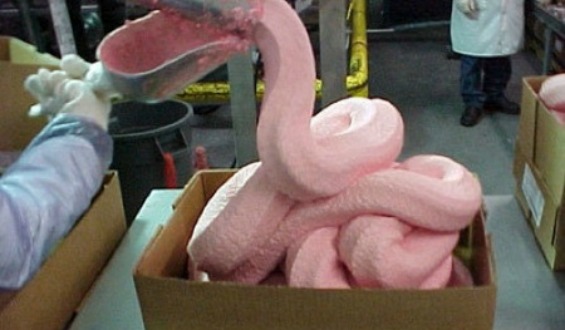I heart me some Mark Bittman! He knows how to stir the pot in all the best ways and questions me to think about where food comes from.
http://opinionator.blogs.nytimes.com/2012/04/03/the-pink-menace/
Who doesn’t love a good burger? Hamburgers are one of the most popular foods in America–studies show each of us eats about 150 burgers per year.
Unfortunately, not all hamburgers, or even turkey or veggie burgers, are created equal. Cooking method, portion size, and choice of bread and toppings can mean the difference between a relatively harmless lunch and a day’s worth of calories, fat, and sodium.
Before you take a bite out of that hamburger you’ve been craving, you might want to know whether it contains “pink slime” — the phrase that has become shorthand for the filler also called “lean finely textured beef.”
Add to that the knowledge the so-called pink slime is composed of mechanically-separated beef trimmings — parts of the cow that once were only used for dog food, not human consumption. And those trimmings are whipped together in a centrifuge and then treated with ammonium hydroxide (ammonia combined with water) to eliminate possible pathogens, particularly E. coli and salmonella, and you have cooked up a perfect stew of controversy.
DON’T ALWAYS COUNT ON LABELS
If you examine a label at the grocery store, it is unlikely to tell you whether a package of ground beef contains the filler as an additive. The U.S. Department of Agriculture has not required such labeling. The USDA also does not require manufacturers to include ammonia treatment on labels, because it says it is a “process,” not an ingredient.
After a major backlash, the whole “pink slime” thing has done a number on ground-beef processors nationwide — causing one to suspend operations at three out of four plants and another to seek bankruptcy protection.
The nation’s leading fast-food chains and supermarkets spurned the product, even though U.S. public health officials deem it safe to eat. Hundreds of U.S. school districts also demanded it be removed from school lunch programs.
WHERE’S THE BEEF?
What people may not have known is that ammonia – often associated with cleaning products – was cleared by U.S. health officials nearly 40 years ago and is used in making many foods, including cheese, baked goods, and chocolate products. Now that little known world is coming under increasing pressure from concerned consumers who want to know more about what they are eating.
SO WHAT TO DO?
Next time you crave a burger, create a healthy one at home. Use 4 ounces (quarter-pounder) of 95 percent lean beef and grill or broil. Enjoy on a whole wheat bun, for fiber, and top with fresh vegetables such as tomato and romaine lettuce leaves. Skip the mayonnaise, but top with low-calorie pickles, ketchup and mustard. Make your own baked fries for a side dish to satisfy your cravings without all the fat and calories.
A hamburger isn’t, by itself, a terrible nutritional choice. Topped with some lettuce and tomato, ketchup and mustard, and a relatively small bun, a burger is a high-protein treat that shouldn’t pack too much fat or too many calories. Unfortunately, the good, old-fashioned American burger has evolved from lean and simple to very fat and very complicated. Stay away from the 1,000+ calorie burgers like the six dollar burgers (some of these burgers has as much as 62 grams of fat or about 560 calories from the wrong kind of fat). Get a regular burger for 300 – 500 calories and add extra lettuce and tomatoes on your burger. The worst part of a burger is actually the bun, the white bread. Try it with a whole wheat bun or even without the bun wrapped in a lettuce leaf “protein-style”.












